Trezor Bridge: The Secure Link Between Your Hardware Wallet
Trezor, one of the most trusted names in hardware wallets, offers a seamless way to interface with your device through Trezor Bridge—a software application designed to securely connect your Trezor hardware wallet to your computer's browser.


What is Trezor Bridge?
A sleek header here, a beautiful layout there, Craft devours other apps for breakfast when it comes to effortless, intuitive note-taking, and dazzling document creation.
Why Trezor Bridge is Important
Enhanced Security
The main advantage of using Trezor Bridge is heightened security. Since the bridge acts as an intermediary, your private keys never leave the hardware device. Every action—whether signing a transaction or verifying an address—is done internally on the device. This dramatically reduces the chances of key exposure through phishing attacks, browser vulnerabilities, or malware.
Reliable Connectivity
Without the Trezor Bridge, communication between the Trezor hardware wallet and browsers would be limited or unstable. The software ensures that both newer and older operating systems can maintain a consistent and secure connection across different browsers including Chrome, Firefox, and Edge.
Future-Proof Compatibility
As browser vendors shift away from supporting extensions due to security concerns, Trezor Bridge ensures long-term compatibility. The bridge allows Trezor wallets to integrate seamlessly with the Trezor Suite and third-party apps like MetaMask and MyEtherWallet, giving users flexibility without sacrificing safety.
How to Install Trezor Bridge
Setting up Trezor Bridge is a simple yet vital step in configuring your Trezor wallet. Here’s how you can do it:
- Visit the Official Website Download the Trezor Bridge from the official Trezor website. Always ensure you’re using the authentic site to avoid downloading malicious versions.
- Install the Application Run the installer for your operating system (Windows, macOS, or Linux). Once installed, Trezor Bridge runs in the background automatically.
- Connect Your Device Plug in your Trezor hardware wallet and access Trezor Suite. The bridge will automatically detect your device and establish a secure connection.
- Authorize Browser Access For added security, the bridge prompts users to confirm access for each connected browser. This step ensures that only trusted browsers can interact with the hardware wallet.
Key Features of Trezor Bridge
- Background Operation: Runs silently without interfering with other applications.
- Auto Updates: Regular updates ensure compatibility with the latest OS and browsers.
- Secure Messaging: All communication is encrypted, preventing unauthorized access.
- Open Source: The code is publicly available for audit, ensuring transparency and trust.
Common Issues and Troubleshooting
Although Trezor Bridge is generally reliable, users may occasionally face connectivity issues. Here are a few solutions:
- Browser Not Detecting Device: Ensure the bridge is running and not blocked by antivirus or firewall software.
- Outdated Version: Check for and install the latest version of Trezor Bridge.
- USB Port Issues: Try connecting to a different USB port or cable.
Trezor's support page offers comprehensive guides to resolve most issues quickly.
Final Thoughts
As the cryptocurrency ecosystem matures, the demand for user-friendly and secure tools continues to grow. Trezor Bridge stands out as a vital component in this security-first approach. By providing a secure conduit between your hardware wallet and web interfaces, it empowers users to manage their digital assets with confidence and ease.
Whether you're a crypto newcomer or a seasoned investor, incorporating Trezor Bridge into your digital security arsenal is a smart move toward safe and efficient crypto management.
Frequently Asked Questions (FAQ)
Q: Is Trezor Bridge mandatory for using a Trezor wallet? A: Yes, if you're using a browser interface or Trezor Suite, the Bridge is essential for device communication.
Q: Can Trezor Bridge be used with multiple wallets? A: Yes. It supports integration with multiple wallets and dApps simultaneously.
Q: Is the Trezor Bridge safe? A: Absolutely. It’s developed and maintained by SatoshiLabs, with open-source code for community audit and trust.
Made in Typedream